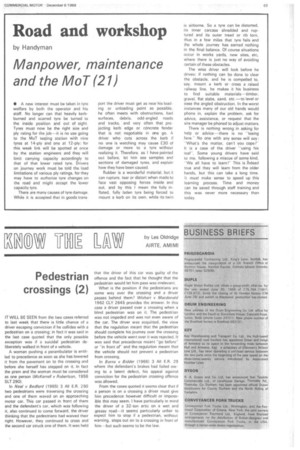Pedestrian crossings (2)
Page 71

If you've noticed an error in this article please click here to report it so we can fix it.
IT WILL BE SEEN from the two cases referred to last week that there is little chance of a driver escaping conviction if he collides with a pedestrian on a crossing; in fact it was said in the last case quoted that the only possible exception was if a suicidal pedestrian deliberately walked in front of a vehicle.
A woman pushing a perambulator is entitled to precedence as soon as she has lowered it from the pavement on to the crossing and before she herself has stepped on it. In fact the pram and the woman must be considered as one person (McKerrell v Robertson, 1956 SLT 290).
In Neal v Bedford (19651 3 All E.R. 250 two pedestrians were traversing the crossing and one of them waved on an approaching motor car. This car passed in front of them and the defendant's car, which was following it, also continued to come forward, the driver thinking that the pedestrians had waived their right. However, they continued to cross and the second car struck one of them. It was held that the driver of this car was guilty of the offence and the fact that he thought that the pedestrian would let him pass was irrelevant.
What is the position if the pedestrians are some way over the crossing and a driver passes behind them? Wishart v Macdonald 1962 CLY 2645 provides the answer. In this case a driver passed over a crossing when a blind pedestrian was on it. The pedestrian was not impeded and was not even aware of the car. The driver was acquitted, the view that the regulation meant that the pedestrian should complete his journey over the crossing before the vehicle went over it was rejected. It was said that precedence meant "go before" or "in front or and the regulation meant that the vehicle should not prevent a pedestrian from crossing.
In Burns v Bidder (1966) 3 All E.R. 29 where the defendant's brakes had failed owing to a latent defect, his appeal against conviction for the pedestrian crossing offence was allowed.
From the cases quoted it seems clear that if a person is on a crossing a driver must give him precedence however difficult or impossible this may seem. I have particularly in mind the driver of a 32-ton artic on a wet and greasy road—it seems particularly unfair to expect him to stop if a pedestrian, without warning, steps out on to a crossing in front of him—but such seems to be the law.








































































































































































